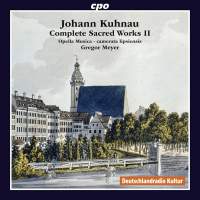Texte paru dans: / Appeared in: |
|
|
Outil de traduction ~ (Très approximatif) |
|
|
Reviewer: Bertil
van Boer
As Johann Sebastian Bach’s
predecessor at the Thomaskirche in Leipzig, Johann Kuhnau set a high
standard for the types of works to be performed there. He also had to
function under the dictates of the town council, many of whom had Pietist
leanings (though were not specifically Pietists themselves). When he was
appointed in 1701, their directive was that he compose succinct works that
did not contain secular styles more appropriate to the theater. Add to this
the notion that all of the music should develop devotion in the worshipers
and one has a Herculean task to comply. Fortunately, Kuhnau knew well that
they were musically challenged that therefore would not really notice any
difference. This led to sometimes acrimonious relationships of the same sort
that Bach was eventually to encounter, not made easier by the occasional
comparison with the Leipzig opera under the young Telemann or his pupil
Johann Heinichen’s satirical portrayal (once he had left Leipzig and was
ensconced in Dresden). Still, Kuhnau produced a series of sacred works that
were seen as exemplary for the time, and this ongoing series is a crucial
step in restoring his legacy as one of the developers of the 18th-century
Lutheran cantata. This second volume, as one might suspect, contains music recorded for the first time. This consists of five cantatas, each of which reflects the colorful instrumental forces that Kuhnau had at hand with the city Stadtpfeifer. Only one, Gott der Vater, Jesus Christus, is short to the point of being perfunctory, consisting only of an instrumental introduction (entitled, as all of them are, “sonata”) and a rather lengthy chorus. Here one is treated less to a conventional cantata than a sacred symphony of the post-Schütz variety. Based upon a tune by Martin Luther, the opening instrumental movement sets it in variation form, replete with some close harmonies and dissonances, as a rather typical church symphony. In the faster section the oboe functions as a cantus firmus underneath which the strings both develop the variation and provide a running countermelody. The chorale fantasy that follows has some flowing and often trippy violin figures, but the exhortation is done in a solid chorale style in the voices. Later in the movement, the antiphonal and contrapuntal sections have an almost anachronistic rhythmic character with continual fanfares. The only thing missing is the versatile tromba da tirarsi, here replaced by an oboe. The effect is not the same, however. The opening cantata, Lobe den Herren, is quite substantial, with a nice contrast in the opening short introduction between the brass and string sections. The namesake chorus offers a strophic statement in which the solo voices, beginning with the soprano, alternate with the full chorus, and the textures are increased as the movement moves to the conclusion. If the town fathers were looking for secularized music, they wouldn’t find it in this work. The solo soprano aria is sedate and plaintive, as far from the putative stage as one can get. The ending is a repeat of the opening chorus, bookending the entire work. The second cantata, Christ[us] lag in Todesbanden, opens with a rather spun-out sonata in which the two brass instruments (cornetts) offset the strings. Their hesitant punctuations in the first aria lend the choral line of the soprano an insistent feeling, while the following chorus “Alleluia, es ist Victoria” is suitably joyous, with the various solo voices weaving among each other before a final expostulation. The second “Lobe den Herrn” has a pastoral feel with a rocking, nasal oboe d’amore complementing the alto and bass solo voices. Only at the end with the “Alleluia” does Kuhnau venture into the realm of vocal virtuosity, with the solo voices, oboe, and violin spinning out coloratura, all of which blends easily but seems a bit too secular. The final cantata, Schmücket das Fest, opens with a dance-like chorus that is a bit too jaunty for the tone, though it fits the text rather well. One must ask what the city fathers may have thought of it, but the sacred concerto texture of the arioso that follows is done in the same secular manner. The gentle “Gelinder West,” with its soft recorders, sets a more pastoral tone, while the final soprano aria probably pushed the boundaries with its minuet rhythm.
From a
performance perspective, the voices of the Opella Musica, a quartet that
doubles as the chorus, are clear and spot on in terms of intonation.
Conductor Gregor Meyer has a good sense of the tempos and interpretation,
keeping things moving along but not rushing. This allows the subtleties of
Kuhnau’s intricate score to come out. One can immediately see how Bach would
have complemented his predecessor’s works. Other than the missing tirarsi,
the disc marks a fine continuance of the complete cantatas, and makes one
look forward to the next installment. | |
|
Support us financially by purchasing this disc from eiher one of these suppliers. Un achat via l'un ou l'autre des fournisseurs proposés contribue à défrayer les coûts d'exploitation de ce site. |
|
|
|
|
|
Cliquez l'un ou l'autre
bouton pour découvrir bien d'autres critiques de CD |
|




